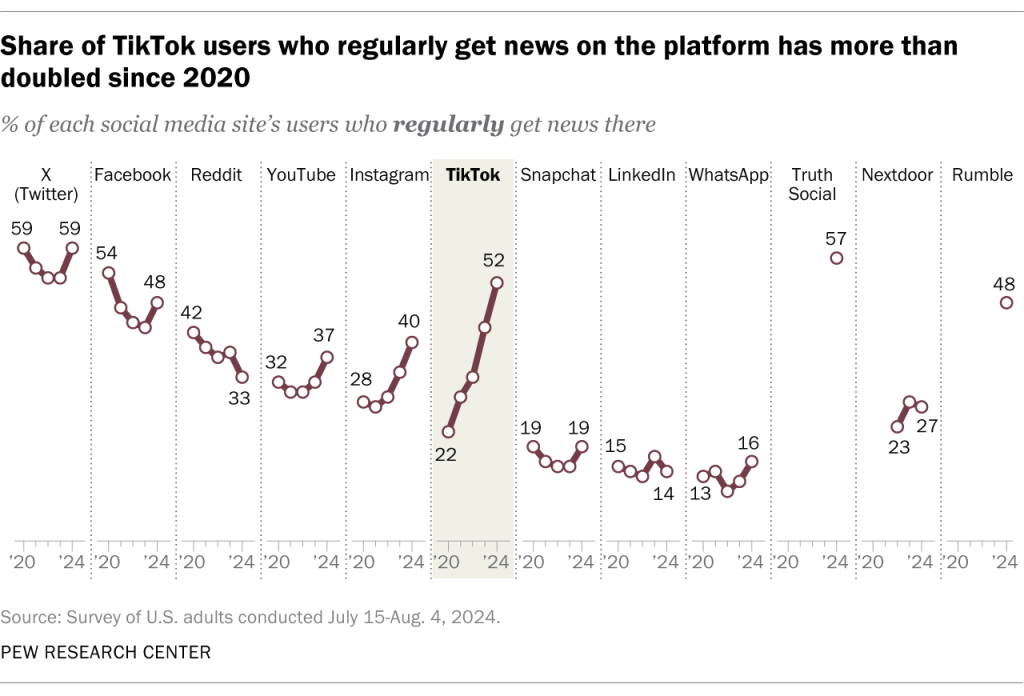This story shows how TikTok went from a fun video app to one of the fastest-growing places where young people get their news.
TikTok used to just be for dances, memes, and random funny stuff. Now, it’s where a lot of people, especially younger adults, get their news. A new study from Pew Research Center says the number of adults who regularly get news from TikTok jumped from only 3% in 2020 to 17% in 2024. For people under 30, it’s even bigger, about 39% say they get news there. This shift makes news feel more accessible, but it also brings risks like misinformation spreading quickly.
This tweet shows that a lot of people are turning to influencers and celebrities for news, almost as much as they turn to professional journalists. That’s huge because it means that the way people get information is changing, news isn’t just coming from traditional sources anymore. Influencers can spread ideas fast and reach younger audiences, but it also raises questions about accuracy and trust. People might assume someone is giving reliable information just because they’re popular, which can be risky. It really highlights why we need to think about media literacy when using platforms like TikTok.
This tweet is a warning about how easy it is for misinformation to spread on TikTok, even about something as important as mental health. A lot of young people get advice and tips from TikTok videos, but this shows that most of the popular ones are misleading. That can be dangerous because it might affect how someone thinks about their own health or how they make decisions. This is one reason why it’s important for users to double check what they see and why professionals stepping in to give accurate info is so crucial. TikTok isn’t just fun, it has real world consequences.
This tweet explains why misinformation spreads so easily on TikTok. The app’s algorithm pushes videos that get lots of attention, regardless of whether the information is true or not. That can make false info go viral really fast. It also points out a bigger problem. A lot of people, especially younger users, might not have the skills to tell what’s real and what’s fake. This is why media literacy matters, knowing how to check sources and think critically about what you see is just as important as the news itself. TikTok’s design is fun and engaging, but it also makes it easy for bad info to spread without people realizing it.
This line chart shows the percentage of TikTok users who regularly get news from the platform, rising from 22% in 2020 to 52% in 2024. It highlights how the app is not just for entertainment anymore, more than half of TikTok users are now actively using it to stay informed. While TikTok is growing fast, users of platforms like X and Facebook still get news there, but TikTok is quickly catching up, especially among younger audiences.
Source: Pew Research Center, “More Americans are regularly getting news on TikTok, especially young adults” (2024).
This bar chart shows how the number of U.S. adults who regularly get news on TikTok has grown from 2020 to 2024, broken down by age groups. You can see that young adults under 30 are the most active, with about 39% now using TikTok regularly for news. The older age groups are much smaller in comparison. This chart helps show just how quickly TikTok has become a major news source for younger people, even though it started as a platform mainly for fun videos and dances.
Source: Pew Research Center, “More Americans are regularly getting news on TikTok, especially young adults” (2024).
In this video, NBC News explains how TikTok creators, including healthcare professionals and informed users, are trying to fight the spread of misinformation on the platform. It shows how some creators correct false claims and provide accurate health information to viewers, while also highlighting the challenges of dealing with content that spreads so fast. This video gives a clear picture of how TikTok isn’t just for entertainment anymore, it’s also a place where important information, good or bad, can reach millions of people.
Source: NBC News, “How TikTok Creators Are Tackling Misinformation” (2021).
This study from JMIR Infodemiology looked at how young women in the U.S. use TikTok for health information. It found that nearly all participants had seen health info on TikTok, either intentionally or by accident, but almost everyone agreed that misinformation is common. Women preferred info from health professionals but still got content from general users. This shows that while TikTok can be a useful place to share accurate info, there’s a big risk if misleading content spreads to millions of viewers.
Kirkpatrick, C.E., & Lawrie, L.L. (2024). TikTok as a Source of Health Information and Misinformation for Young Women in the United States: Survey Study. JMIR Infodemiology. https://pmc.ncbi.nlm.nih.gov/articles/PMC11150891/
TikTok is clearly more than just an app for dances or memes. It’s changing the way young people get news and health information. While it can make knowledge easier to access, it also spreads misinformation quickly. Users need media literacy skills, and professionals should keep sharing accurate info so people can make safe, informed choices.
TikTok’s rise as a news source is fast and significant, especially among young adults. It provides new opportunities for reaching audiences but comes with the risk of misinformation. By understanding these trends and promoting media literacy, both users and creators can make TikTok a safer place for news and information.
